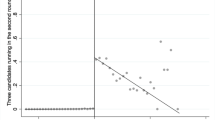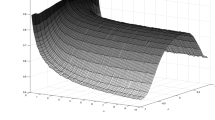Abstract
We use historical data to estimate the probability that a presidential candidate could win the popular vote and subsequently lose in the electoral college (a divided verdict). We replicate the model constructed by Merrill (1987b), and improve its robustness by replacing the normal distribution with the beta distribution, and by extending the historical time period to 1880–1984. The changes indicate greater inefficiency for the Democratic party, which was more likely to have unnecessarily large majorities in particular (Southern) states. We revise the model further to include the changes over time in electoral size and in voting patterns among the states. This dynamic model indicates that recent party realignments have decreased the probability of divided verdicts in moderately close elections.
Similar content being viewed by others
References
Banzhaf, J.F. (1968). One man, 3.312 votes: A mathematical analysis of the Electoral College. Villanova Law Review 13: 304–332.
Fisz, M. (1973). Probability theory and mathematical statistics. New York: Wiley.
Hastings, N.A.J. and Peacock, J.B. (1975). Statistical distributions. New York: Wiley.
Key, V.O. Jr. (1955). A theory of critical elections. The Journal of Politics 17(1): 3–18.
Levesque, T.J. (1984). Measuring state power in presidential elections. Public Choice 42(3): 295–310.
Merrill, S. III. (1978a). Citizen voting power under the Electoral College: A stochastic model based on state voting patterns. SIAM Journal of Applied Mathematics 34(2): 376–390.
Merrill, S. III. (1978b). Empirical estimates for the likelihood of a divided verdict in a presidential election. Public Choice 33(2): 127–133.
Peirce, N.R. (1968). The peoples president. New York: Simon and Schuster.
Yunker, J.H. and Longley, L.D. (1976). The electoral college: Its biases newly measured for the 1960s and 1970s. Beverly Hills: Sage.
Author information
Authors and Affiliations
Additional information
We wish to express our appreciation to Thad Brown, Allen Russell, and Eric Anderson for their aid in the research design and comments on earlier drafts of the manuscript.
Rights and permissions
About this article
Cite this article
Ball, W.J., Leuthold, D.A. Estimating the likelihood of an unpopular verdict in the electoral college. Public Choice 70, 215–224 (1991). https://doi.org/10.1007/BF00124483
Received:
Accepted:
Issue Date:
DOI: https://doi.org/10.1007/BF00124483




